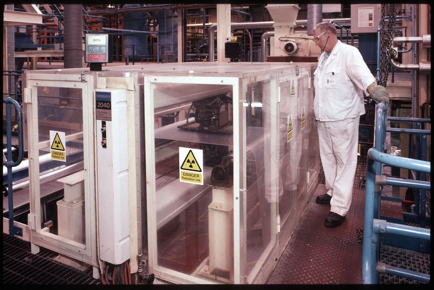pdf Faulty shutter on a scanning beta thickness gauge (1.77 MB)
Description of the incident
Gauge operators noticed that the system detector on a scanning beta thickness gauge was registering the presence of radiation, even though the green warning lights indicating that the shutter was closed were illuminated. However, the radiation protection supervisor was not informed of this for approximately one week.
When the supervisor was made aware of the fault, he went to investigate immediately. A Geiger tube radiation meter was used to measure the beta radiation count rate at the edge of the guide plates.
At the time of the incident, the activity of the installed strontium-90 source was approximately 120 MBq. Normally, with the shutter closed, a typical reading would be around 3 counts per second. However, the supervisor found that the monitor reading was in excess of 2000 counts per second, ie. above the maximum scale reading for the instrument. This indicated that the shutter was open, despite the warning lights indicating that the shutter was closed.
The supervisor prevented further access to the gauge by locking all access gates and posting warning notices informing staff of the situation. Advice was then sought from the radiation protection adviser (RPA) and the service agent contacted to repair the faulty shutter. The shutter was repaired within a few days and the service agent also checked the company’s other gauges and found that these were all in full working order.
The RPA visited the company to assist with an investigation and estimate the doses received by employees due to the faulty gauge.

Radiological consequences
Nine members of staff had had close access to the gauge in the days leading up to the discovery of the faulty shutter. They had performed tasks such as re-threading the line and cleaning and tidying the production area. However, there had been no tasks such as foil changes carried out, which require prolonged close access to the source.
These employees were interviewed to establish as accurately as possible the length of time and their proximity to the gauging system so that the potential doses could be estimated. Personal dosemeters were also returned to the dosimetry laboratory for urgent assessment.
The maximum beta radiation dose to the skin was estimated to be 0.14 mSv. Any whole body doses due to bremsstrahlung radiation would have been negligible.
Lessons learned
Equipment should be maintained in good condition to reduce the risk of failure of safety critical components.
All employees required to work in the vicinity of a radioactive source must receive appropriate information and training, so that they are aware of the potential risks and the necessary precautions to take.
Radiation monitors must be used to verify the correct closure of the shutter before working close to sources of radiation, particularly where significant radiation exposures may occur. Records must be kept to demonstrate that this requirement is complied with.
Contingency plans must cover all reasonably foreseeable incidents and they must be implemented promptly on discovery of a problem.
pdf Faulty shutter on a scanning beta thickness gauge (1.77 MB)
